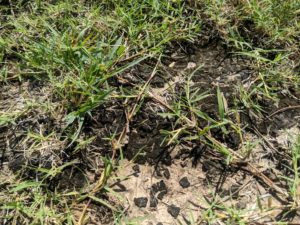Algal Scum
Causal agent: Blue-green algae – cyanobacteria forming long filaments of cells including Nostoc and Oscillatoria spp.
Host Grass: All turfgrass species.

Figure 1. Algal scum in the bermudagrass lawn. A green scum develops on the surface of wet soil, and later when the soil dries out, black algal crust appears.
Cause and Symptoms: Although algae do not infect turfgrass directly, they are highly invasive and out-compete grasses for space and nutrients. Algal scum can be a chronic problem, especially on turf with poor air circulation and compacted soils in wet or shaded areas (Figure 1). Algal growth is encouraged by extended periods of rainy, overcast, and warm weather. During wet conditions, a slimy algal coating forms on the soil surface in less-dense sections of turf. These algal scums slow water infiltration, keep soil surface wet for extended periods of time, and impede oxygen movement into and toxic gas diffusion out of soils. These conducive environmental conditions increase stresses on turfgrass, which eventually make leaves yellow and chlorotic. In the worst cases when algal scum keeps filling air spaces or pores in the soil, algal scum promotes the development of a “black-layer” in soils (Figure 2), where anaerobic conditions form, and toxic hydrogen sulfide gas is generated. Under this condition, turfgrass gets stressed and roots cannot grow properly.
Control and Management: Key cultural practices that reduce the occurrence and severity of the disease include:
- Maintain proper soil moisture and minimize surface pooling
- Control and manage shading
- Avoid soil compaction
- Encourage dense turfgrass stands and health

Figure 2. Black layer in highly managed bermudagrass. Blackening results from sulfide precipitation after hydrogen sulfide gas binds with iron or divalent cations in soil.
The primary control of algal scum requires alleviating wet soil conditions by improving drainage, aeration, and proper irrigation practices (i.e. watering infrequently and deeply). Air circulation and sunlight penetration can be improved by selectively pruning or removing trees and shrubs from the site. Make sure to raise mowing heights as this can reduce stress on the grass as well as limit algae access to sunlight. Raising the mowing height, particularly in shaded areas, will be very helpful for turfgrass to have the edge over algae in the competition for sunlight. In most cases, algicide applications are not recommended for turf but must be done carefully if used since they can also cause burning of turf. The best long-term solution for avoiding algal encroachment is maintaining turf in dense and healthy conditions.
Content edited by:
Young-Ki Jo (ykjo@tamu.edu, Professor and Extension Specialist)
Raleigh Darnell and Paul Goetze (Extension Assistant)
Department of Plant Pathology & Microbiology, Texas A&M AgriLife Extension Service
September 31, 2021
